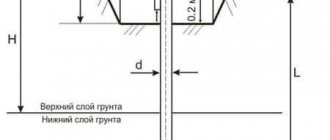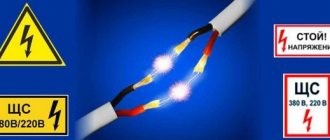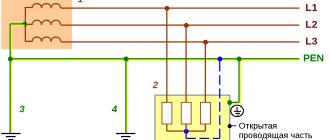The most common electrical questions and answers to them
Electrical wiring, connection, laying of electrical wires and cables
External or internal wiring - which is better?
Both options for installing electrical wiring are used in the process of electrical installation work on residential, administrative or industrial real estate. Wiring is installed much faster using the open method. This option is also considered more economical. But the advantages of internal electrical wiring are higher reliability and electrical safety, as well as an attractive appearance.
The option of external installation of electrical wiring is more popular in country houses, country cottages and wooden houses. A special feature of such buildings is the absence of plaster on the walls, and therefore there is no possibility of installing electrical cables in it. However, it is mandatory to hide the wiring in corrugated pipes. This allows you to increase fire and electrical safety when operating the electricity supply system.
Which wires are better to install - copper or aluminum?
There is no clear answer to this question. Modern technologies most often involve the use of copper wires. This is explained by the fact that such wires are capable of withstanding very high current loads, and therefore can withstand higher power. However, from an economic point of view, aluminum wires are cheaper, and therefore are popular when organizing power supply systems in small private households, country houses and other facilities.
Is it possible to combine copper with aluminum?
It is strictly forbidden to connect copper and aluminum wires when laying internal wiring or in a groove. The main reason is the rapid oxidation of copper upon contact with this metal. The result of this interaction is loss of contact and gradual destruction of the wire core. To ensure the supply of electricity between these two types of wires, connection blocks are used that are specially designed to reduce the occurrence of the above risks.
Do I need to secure the wire in the groove?
The internal installation method involves hiding electrical wiring in special grooves and then plastering them. In such a situation, it is allowed to lay wires without fastening them, since they will be held in place by a layer of plaster. However, some experts attach wires to ensure convenience when performing plastering work. In this case, special clamps – “clips” – are used for fastening.
How deep should the cable be laid in the ground?
During the arrangement of cottages and country houses, electrical wires are often laid underground. To do this, a trench is first dug. In comparison with the air method of supplying electricity to the serviced object, this method is considered more rational.
The depth of the trench for laying the electrical cable is determined by the type of soil on the site. The most acceptable depth range is from 30 cm to 1 m. The wire, in turn, is enclosed in a corrugated pipe. This provides additional insulation protection.
Is it necessary to install an RCD?
The main purpose of installing an RCD (residual current device) is to protect a person from possible electric shock due to its leakage. Current leaks usually occur due to damage to the insulating layer of the electrical conductor. Thus, the installation of an RCD is, although not mandatory, recommended. You can do without an RCD if reliable circuit breakers are installed in your house.
General electrical questions
At what height is it recommended to place sockets and switches?
Taking into account modern trends, switches should be located at the level of your lowered hand, so that when you need to turn on the light in the room, you do not need to reach far to the switch.
Sockets in modern houses are placed at a height of about 50 cm from the floor.
However, each homeowner has the right to independently choose at what height to install switches and sockets. There are no technical restrictions as such.
Which is better: plastic or ceramic socket?
Ceramic sockets have shown the greatest reliability and longer service life. In addition to the strength of the material from which such elements are made, they are also designed to withstand heavy loads. Compared to plastic sockets, ceramic sockets do not melt if powerful household electrical appliances are connected to them or operate for a long time.
Is it allowed to install an outlet in the bathroom?
Despite the seemingly high level of danger of electric shock in the bathroom (due to high humidity), installing sockets in this room is completely acceptable and safe if you follow certain rules. It is important to remember that outlets should not be located too close to a water source/plumbing fixture. You should also exclude the possibility of accidental contact with moisture on these elements.
The modern market also offers solutions such as special sockets for bathrooms. They are equipped with special protection against moisture and are safe to use.
How are the wires marked? Wire color
Today, the electrical engineering and equipment market offers a wide range of electrical wires, and the color marking of their cores is very diverse. However, when choosing an electrical cable for laying the power supply system at home, you should remember the basic color: conductors with yellow-green insulation are intended for grounding, blue insulation indicates the need to use an appropriate cable for neutral conductors, and conductors with red insulation are used for arranging phase conductors .
How are telephone wires connected?
A similar question relates indirectly to the electrical field. However, you should not ignore it. Thus, a special mounting box is used to connect the telephone cable. It provides connection of conductors to each other using terminals and clamping screws. If the box is not available or you need to connect the wires as quickly as possible, the most common method is twisting. In this case, it is important to reliably insulate the conductors among themselves, as well as the entire area of the connection made.
What other material can be used instead of electrical tape?
During the operation of a local electrical network, homeowners are often faced with a situation where it becomes necessary to perform one or another electrical operation. Any action involves ensuring reliable insulation of the wires. But you may not have insulating tape at hand. In such cases, it can be replaced with PVC tubes or special heat-shrinkable tubes. If such materials are not available, it is possible to use almost any adhesive dielectric - medical plaster or ordinary tape - to construct the insulation.
We have presented a list of the most frequently asked electrical questions, and the answers to them should help you solve any electrical problem if necessary.
One of our services: Design of low-current systems - read more.











